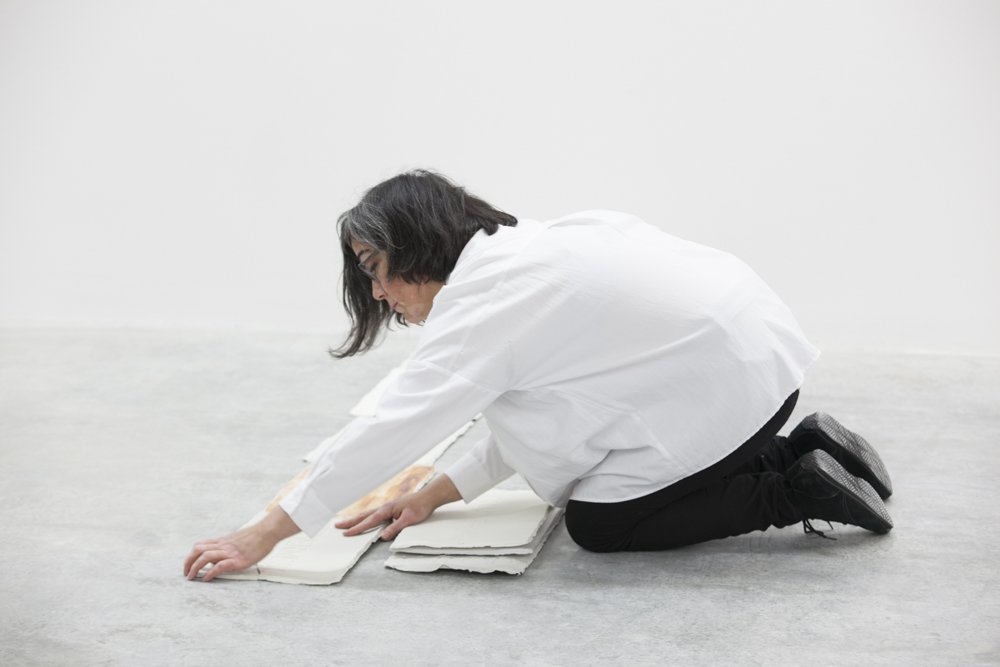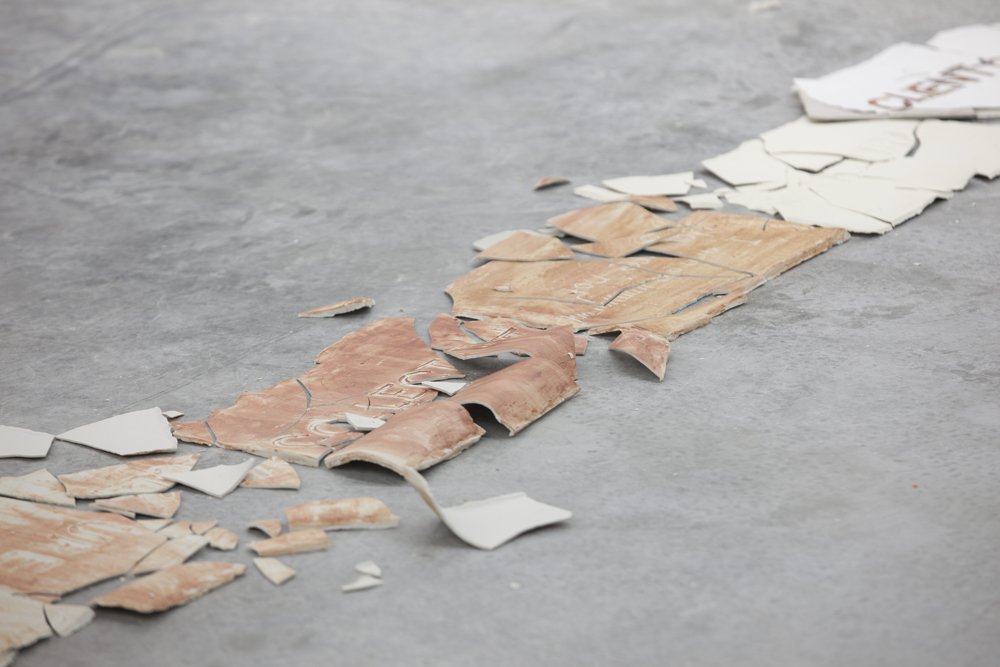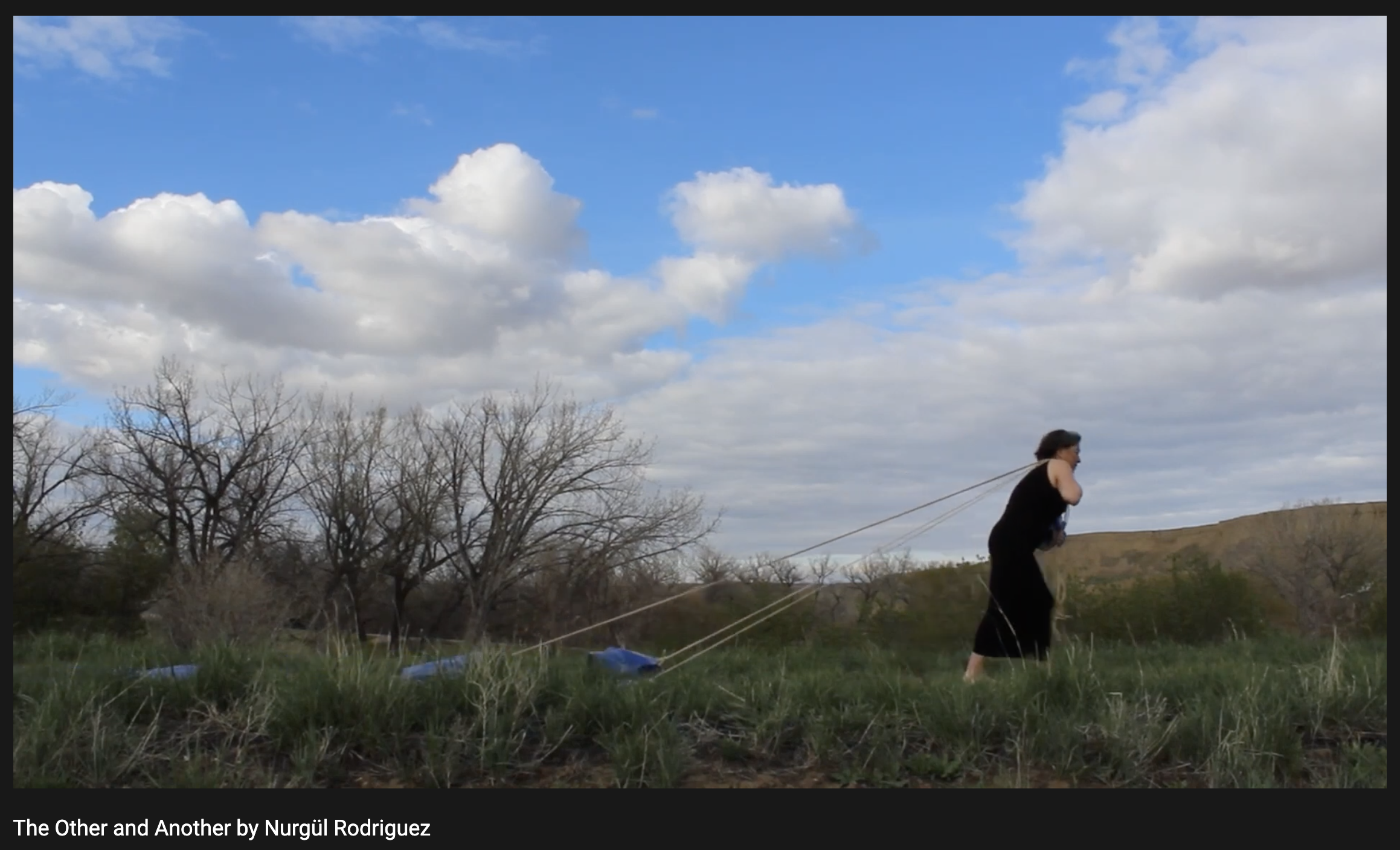Interview with Nurgül Rodriguez Part Three
Nurgül Rodriguez, Out of Place, 2020, glazed porcelain installation and live exchange, Remai Modern, Saskatoon. Photos: Golden Media Company.
Alana: Remediation is often understood as remedying something, usually in the context of environmental repair to damaged or contaminated land. It can also be defined as “righting a wrong”. How do you see remediation in relation to your work?
Nurgül: The material I use in my work comes from the land. It is not a completely native material. The clay body I am using, half of it is coming from New Zealand. We import soil from another land far away. Where I made these works, at Medalta, the land is damaged. Until new materials like plastic were invented, clay was used. All the tubes, bricks, and containers were made at Medalta in Western Canada. Later things for the military. It is extracted clay. Who asked [permission]? How much we are repairing it, I don’t know.
That’s why in my work I use feet, a fragmented body. Are we really healing? Do we really heal the land? Healing starts from humans, first, the human soul has to heal, then other forms of healing come. We have to accept the history and after that healing can come.
I came in 2009, but in 2012 on October 12th I became a landed immigrant here. I believe that I hurt many different people entering this country as a new settler. I had good intentions but when you have intentions you have to know what is going on. Accessible knowledge is part of the healing. Bringing a fragment, [reflects] how we start, step-by-step, maybe
Also, clay is coming from the land, local clay. I spent time in that natural environment [in Medicine Hat]. How much the truth of the natural environment is reflected in the cultural environment I don’t know.
A: There’s inherent violence in fragmentation.
N: I know that science has ways of repairing it [the land] but I believe that education is going to help us. At the same time, the Alberta Education Minister is trying to remove realities from our curriculum. We are not doing it the right way. Denial is part of it. The land is crying. All this violence. All this human behaviour. Crying doesn’t have to be flooding. Things are changing but at the same time, my work is a very small part in discussing these things. It has just started. That’s why I am so happy to be part of Remediation Room, the other works will complete my work. The other artists are going to teach me a lot.
A: In your work, the themes you investigate include displacement, belonging, identity, and migration as well as the concept of multiculturalism in what is now known as Canada. Over the last year, amid calls for racial, social, and climate justice, racism and hate-motivated attacks have risen in Alberta and elsewhere. What role do you see art taking at this time and specifically in Alberta?
N: I think that we have to focus on adult education. We have to educate adults. When I was attending a women’s rights webinar they were saying, first, we have to educate adults. Adult learners are more complicated. We can use formal and informal, conventional and unconventional pedagogies. As an artist, I try to research and read a lot and look at how I can do that. More and more research-creation can be used in social studies and humanities as a methodology, and I found myself there. My aim was always to make my work be completed by the audience. We don’t have to teach everything, but arts-based learning is an important part of education. That’s why I focus on socially engaged arts practice. How can we develop new pedagogies through community-based art? I tried to go there but it was a long way to get there. Research-creation gives me a method, it allows me to integrate different disciplines. Skills are also important. Artmaking in contemporary craft can really bring people together. Artmaking is part of a process of social change, undoing, revealing ourselves, and relearning.
Nurgül Rodriguez, A LOT TO LEARN, 2018. IKGLive 2, Performance. Photos: Jeremy Pavka.
A: A lot of Western education is focused on getting the right or wrong answer. We don’t always think about what that actual process of learning is and what that experience is and how we learn in different ways in working with different materials and other people. It is also hierarchical, siloed, and becomes very focused on the individual. I like what you are saying about how art is a process, and you don’t know what the end goal is.
N: You know where you are going to arrive. You make decisions. You make a decision that the audience is going to complete the work. At the same time, you don’t know where it is going to go.
Nurgül Rodriguez, In the Vessel of my Skin, Porcelain body of works at the Ledge Gallery, ARTS COMMONS, 2021, solo exhibition. Image: Arts Commons.
A: Part of the intention with Remediation Room is to assist artists in developing their research and experimenting with projects and materials that they can carry forward into other projects.
Some of the same feet from this work are configured in a circle within the space of the gallery for your current exhibition In the Vessel of my Skin at The Ledge Gallery (2021). Do you see them functioning differently in the space of the gallery? And will you continue to bring these sculptures forward into other works and spaces?
N: The feet had to come there as a circle formation. I wanted to reflect my huge respect for frontline workers. I was thinking about how much they work and how they have to fight for respect. I wanted to give respect to how people were supporting each other. For example my husband had to go to work all this time. He had to put on this blue mask. You carry a lot of fear.
In the exhibition, everything is blue and white. How we became blue, how we were very vulnerable.
The feet are distanced but still together. For this artwork, there are 12 or 11 pairs. How much we were not present but how much we were still present and how we were feeling that. I wanted to talk about working-class vulnerability and the vulnerability of women’s bodies. Domestic violence increased during the pandemic. It was heartbreaking. Systemic racism, classism, sexism… I was making notes, whatever I was hearing and reading [during the pandemic]. This is how the exhibition at The Ledge Gallery came to be.
It seems like they [the feet] are all coming from the same mold, like all of us, but the conditions are different. I called the work In the Vessel of My Skin. Workers carried us through the pandemic. I hear the Alberta government explained that they want to take a 3% rollback of nurses’ money?! That is heartbreaking. Taking money back?
I think this work touches on all of these kinds of things, how the human body is treated in systems and how otherness is practiced.
Nurgùl Rodriguez, The Other and Another, 2021. Click to view.
A: To me, The Other and Another (2021) is one of the most compelling pieces at The Ledge Gallery. I am drawn into the video, but it is uncomfortable and disturbing. A slow unfolding. In it, we see you wearing a black dress and dragging a fragmented cast of your body across the landscape in Medicine Hat, like a ritual act of mourning.
N: This performance, all this burden. First, I tried to photograph the ceramic pieces of my body on the land. When I was in Home Depot, I found this thread or rope and I said, ha! I realized everything had to be pulled. It came together. It felt like my life, like I am pulling so much. I was pulling my own body. Our bodies are valuable. This work just came out… how we are trying, and how much we have to work. Those broken parts of the body… we are not doing very well.
I turned 50 years old at Medalta. Noriko, the Coordinator prepared a cake. We were sitting around, and a friend of someone asked me, what wisdom can you give us? What do you carry? These questions struck me so much. I appreciated the question, but I didn’t expect it from anyone.
If I had a chance right now, I would clean all this guilt from my soul and heart about whether or not I am doing all of my roles correctly, as a mother, as a wife, or...other roles. I want to explore these ideas more and how I can take my work there.
A: Thank you so much for taking the time to speak with me today. Is there anything else you wanted to say about the work?
N: I just want to say that it took a while for me to find the right project for the Remediation Room. I was still being educated about the land and the history. That’s why it took time. You brought me along gently and patiently, supported me, mentored me, and you observed all these processes. I can see that in the questions. Thank you so much.
A: Thank you for being part of this project.
N: I think this project changed a lot for me, especially these days how the earth is reacting to us. Renewable energies are coming but I don’t know how renewable they are, but everyone has to change. I have learned a lot.
Nurgül Rodriguez, His·to·ry on strange soil, 2021. Porcelain, photography, public intervention / performance, Provincial Courthouse, Stop 2, Historical Walking Tour: Downtown Medicine Hat. Courtesy of the artist.
Works Cited
Historical Walking Tour: Downtown Medicine Hat. Alberta Culture Historic Sites Service, updated 1984, http://open.alberta.ca/publications/historical-walking-tour-downtown-medicine-hat.
Rodriguez del Ojo, Nurgül. in a new land: (be)longing. 2017. Unpublished master's thesis. The University of Calgary, doi: 10.11575/PRISM/26497.






